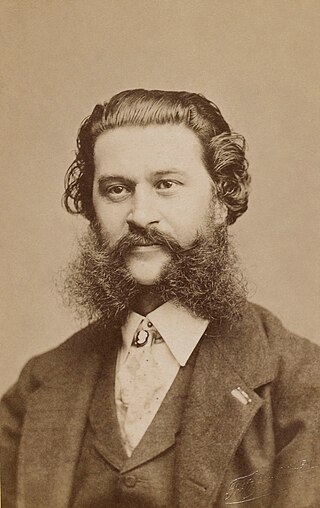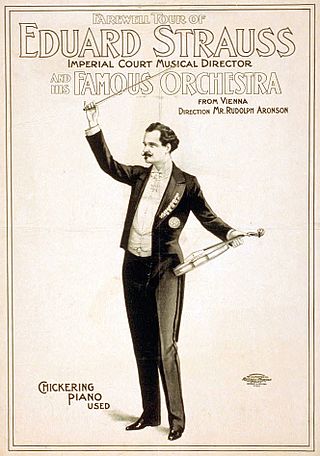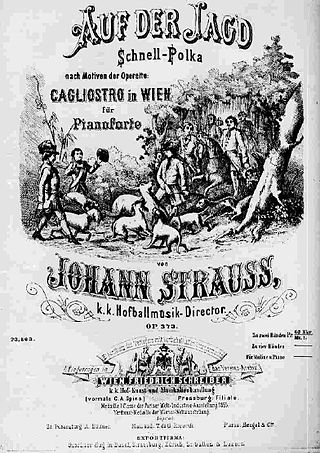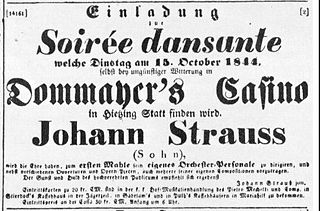Related Research Articles

Johann Baptist Strauss II, also known as Johann Strauss Jr., the Younger or the Son, was an Austrian composer of light music, particularly dance music and operettas as well as a violinist. He composed over 500 waltzes, polkas, quadrilles, and other types of dance music, as well as several operettas and a ballet. In his lifetime, he was known as "The Waltz King", and was largely responsible for the popularity of the waltz in Vienna during the 19th century. Some of Johann Strauss's most famous works include "The Blue Danube", "Kaiser-Walzer", "Tales from the Vienna Woods", "Frühlingsstimmen", and the "Tritsch-Tratsch-Polka". Among his operettas, Die Fledermaus and Der Zigeunerbaron are the best known.

Eduard "Edi" Strauss was an Austrian composer who, together with his brothers Johann Strauss II and Josef Strauss made up the Strauss musical dynasty. He was the son of Johann Strauss I and Maria Anna Streim. The family dominated the Viennese light music world for decades, creating many waltzes and polkas for many Austrian nobility as well as dance-music enthusiasts around Europe. He was affectionately known in his family as 'Edi'.

Carl Michael Ziehrer was an Austrian composer. In his lifetime, he was one of the fiercest rivals of the Strauss family; most notably Johann Strauss II and Eduard Strauss.

Wiener Blut Op. 354 is a waltz by Johann Strauss II first performed by the composer on 22 April 1873. The new dedication waltz was to celebrate the wedding of the Emperor Franz Joseph I's daughter Archduchess Gisela Louise Maria and Prince Leopold of Bavaria. However, the waltz was also chiefly noted by Strauss' biographers as the début of Strauss with the Vienna Philharmonic Orchestra where for many years, the Philharmonic had dismissed any association with the 'Waltz King' as it had not wished to be associated with mere 'light' or 'pops' music. The festival ball celebrating the event was held at the Musikverein Hall which is the venue for the present day Neujahrskonzert.

Waltzes from Vienna is a 1934 British biographical film directed by Alfred Hitchcock, sometimes known as Strauss' Great Waltz. It was part of the cycle of operetta films made in Britain during the 1930s.
Mephistos Höllenrufe, Op. 101, is a waltz composed by Johann Strauss II in 1851. It was first performed at the Vienna Volksgarten as part of a festival preceding Strauss' departure for a tour of Germany. The title of the composition is a quotation from the Bible: "And the devil [Mephistopheles] [...] was cast into the lake of fire and brimstone, where the beast and the false prophet are, and shall be tormented day and night for ever and ever". A reporter for the Wiener Allgemeine Theaterzeitung commented on Strauss' waltz that it "received such a favourable reception, on account of its effective and original melodies and brilliant instrumentation, that it had to be repeated three times". Especially colourful, and keeping with the work's ominous title, is the second waltz theme: its cheerful, ascending tune is suddenly interrupted, and then answered by a sinister chromatic descending passage. Some of the waltz themes of the work are found in close proximity to one another in the earliest of Strauss' "sketchbooks", and were probably written in the first half of 1851.
Seid umschlungen, Millionen!, opus 443, is a waltz composed by Johann Strauss II. It was first performed at the Great Hall of the Musikverein in Vienna in March 1892. The title of the waltz was borrowed from Friedrich Schiller's Ode an die Freude. The composition was dedicated to Strauss' close friend Johannes Brahms.

Bei uns z'Haus, Op. 361, is a Viennese waltz composed by Johann Strauss II for the 1873 Vienna World's Fair. It was first performed in August 1873 at the 'Neue Welt' establishment in Hietzing, Vienna.
Phänomene (Phenomena), opus 193, is a waltz composed by Johann Strauss II. The waltz was dedicated to the technical students of the Vienna University, and was first performed on the occasion of their ball in the Sofienbad-Saal in February 1857. This composition belongs to the series of Strauss waltzes which reflect the composer's fascination for avant-garde orchestrations and harmonic styles of Hector Berlioz and Richard Wagner.

"Auf der Jagd", op. 373, is a polka composed by Johann Strauss II. The composition is based on melodies in Strauss' operetta Cagliostro in Wien.

Herzenslust, Op. 3, is a polka composed by Johann Strauss II in the fall of 1844 for his debut as a composer at the Dommayer's Casino establishment in Vienna. It was performed along with several of Strauss' other early compositions, such as the waltzes Sinngedichte and Gunstwerber, and the Debut-Quadrille. Reviewing Strauss' debut, the journal Der Wanderer noted that both the Debut-Quadrille and the Herzenslust Polka "are so piquant in their inspiration, and handled with such glittering effect in the instrumentation that we […] have to recognise and commend the bold and exuberant talent of Strauss Son."

Sinngedichte, Op. 1, is a waltz composed by Johann Strauss II in 1844 for his debut as a composer at Dommayer's Casino in Vienna. The waltz was played along with several other compositions that Strauss had written for the occasion, such as the waltz Gunstwerber and the polka Herzenslust. The waltz was an unprecedented success when first performed, and had to be repeated a record nineteen times.
Freikugeln, opus 326, is a polka composed by Johann Strauss II. The composition commemorated the 3rd German Federal Shooting Contest, which attracted no less than ten thousand entrants from around the world. The work was first performed in July 1868 at the Vienna Volksgarten.
Waldine, Op. 385, is a polka-mazurka composed by Johann Strauss II. The title is taken from one of Strauss' operettas, Blindekuh. Waldine was the last, as well as the least successful, of the five orchestral dance compositions that Strauss had arranged on tunes from the operetta, having been first performed an entire year after the premiere of the operetta, where it was conducted by Eduard Strauss in the Musikverein in Vienna on December 7, 1879.
Promotionen (Graduations), Op. 221, is the name of a waltz composed by Johann Strauss II. It was dedicated to the law students at Vienna University, and was first performed under the title of Die Präparanden, a term referring to students who are preparing for their final examinations. The waltz was not very successful when first performed in the Sofienbad-Saal on February 8, 1859: the Fremden-Blatt, although praising the execution of the waltz, said that it "lacked the rhythm and melody of older Strauss compositions." However, a reviewer for the Wiener Allgemeine Theaterzeitung was less critical of the composition, commenting that "in particular the first, third and fifth [waltz sections] are rich in fresh and attractive melodies [...] through this composition Strauss has lately demonstrated that he still has at his disposal a profusion of piquant and original melodies."
Abschied von St. Petersburg, opus 210, is the name of a waltz composed by Johann Strauss II. The work was first performed at a benefit concert in Pavlovsk on September 5, 1858, as part of a tour of Russia that Strauss was conducting. In keeping with the vogue then current in Russia for the French language, the work was entitled as Mes adieux à St. Pétersbourg. Less than a week after his return to his home city of Vienna, Strauss conducted the first Viennese performance of the work at the Vienna Volksgarten.
Farewell to America is the name of a waltz composed by Johann Strauss II. In the immediate wake of the composer's visit to the United States in the summer of 1872, when he conducted several times in Boston and New York, no less than seven publishers issued waltzes supposedly composed by Strauss. Only two from the total of nine compositions that were published are known to have been performed by Strauss during his tour of the United States: the Jubilee Waltz and the Manhattan Waltzes. It is unknown whether or not the other compositions that were published were written by Strauss while he was in America, completed by him after his return to Vienna and sent through the mail, or that some of the publications had nothing to do with Strauss himself, but were compiled by publishers anxious to benefit from Strauss' American tour and the clamour for new Strauss music.
Charivari is a composition for orchestra by HK Gruber. It is based on a polka by Johann Strauss II, Perpetuum mobile, Op. 257. Charivari was completed in 1981.

Eduard Leopold Maria Strauss, commonly known as Eduard Strauss II to distinguish him from his grandfather, was an Austrian conductor whose grandfather was Eduard Strauss I and whose uncle was Johann Strauss III.

Egyptischer Marsch, Op. 335, is a march composed by Johann Strauss II. It was commissioned for the inauguration of the Suez Canal, celebrated on 17 November 1869 in Port Said, where Emperor Franz Joseph I of Austria officiated at the ceremonial opening, though it was first performed on 6 July 1869 in Pavlovsk, Saint Petersburg, under the title "Tscherkenssen-Marsch". Strauss later dedicated the work to Frederick I, Grand Duke of Baden.
References
- ↑ "STRAUSS II, J.: Edition — Vol. 15 CD". NaxosDirect. Archived from the original on 14 July 2011. Retrieved 9 October 2008.